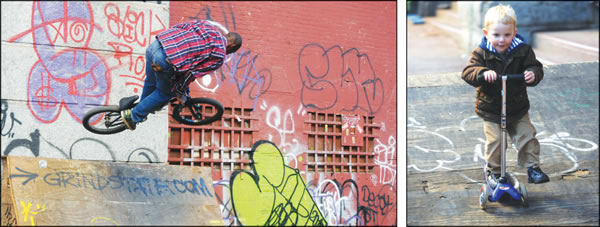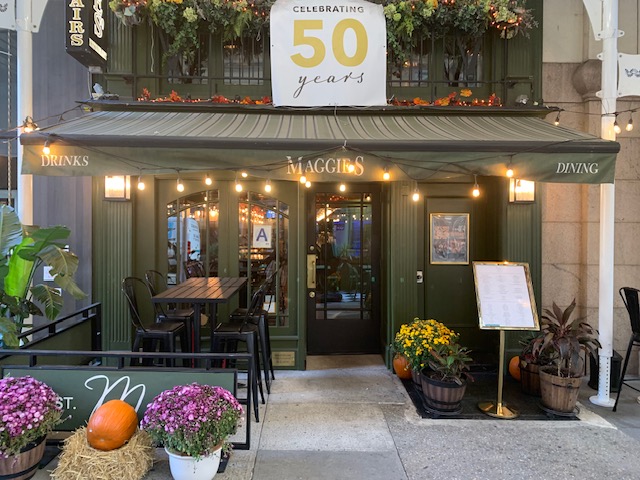By Julie Shapiro
The Brooklyn Banks is a place with no rules except gravity.
The legendary skateboard spot in the shadow of the Brooklyn Bridge feels like a world unto itself. The graffiti-scrawled brick slopes on the Manhattan side are dotted with broken glass and blowing garbage. Teenagers bound over obstacles, flying through the air after their board, twisting at impossible angles. It all seems very far from the rule of the city.
That’s about to change, as the city plans to close down the skate park as soon as December to use the space for construction staging. The Banks may not reopen until 2014, when the Brooklyn Bridge rehabilitation project is scheduled to finish. Until then, New York will be without one of the world’s top skating spots, and skateboarders will have to find a new place to go.
Since Downtown Express first reported the impending Banks closure last week, the word spread quickly through the skateboarding community via e-mails and blogs. This is not the first time the skate park has been temporarily taken away — once was in the early ’90s, under Mayor Rudy Giuliani, and once was several years ago, when the city wanted to turn the entire area into a green park.
“It’s the same thing all over again,” said Steve Rodriguez, the owner of 5boro Skateboards who is credited with preserving the Banks back in 2004, though the city did turn part of the area into an unused green space. Rodriguez said he’s ready to fight for the Banks again and could easily get hundreds of people to turn out to a public hearing on the closure. Even if the city left 30 percent of the space intact, that would be enough room for people to skate, Rodriguez said.
But the city has already made a final decision to close the whole space, said Scott Gastel, spokesperson for the city Dept. of Transportation. Gastel would not say when the Banks would close, but he did say the city intended to reopen it as a skateboard park eventually.
Rodriguez and other skateboarders said it was hard to describe the importance of the Banks to those who don’t skate, but they found no shortage of metaphors.
“It’s like saying, ‘We’re going to remove the Statue of Liberty, why is that bad?’” Rodriguez said. “It’s a spot that’s been skated since the ’60s and ’70s. It’s the historic center of skateboarding on the East Coast. It’s like a shrine, almost.”
“Deathbowl to Downtown,” a recent documentary on skateboarding in New York City, narrated by Chloe Sevigny, includes a segment on the Banks entitled “The Meeting Place,” a phrase many skateboarders echoed.
Jefferson Pang, 38, known as New York City’s first professional skateboarder, said he gets choked up when he thinks about the park being taken away.
“The idea that kids starting to skate won’t have access to something so real and authentic — it’s like seeing CBGB’s close,” Pang said. “The staples of subculture are fading.”
In the 1980s, when Pang first started skating the Banks, it was a breeding ground for the skateboarding movement, the place where everyone practiced, learned new tricks and showed them off.
“The Banks was our Vatican,” Pang said. “It was our place of worship.”
“It was like our little heaven,” said Jay Maldonado, 32, who grew up on the Lower East Side and first went to the Banks when he was 10. “We got kicked out of everywhere. This was the place where you didn’t get kicked out.”
Maldonado called the Banks a “safe haven” for kids past and present, a nonstop party that was about skating prowess rather than drinking or drugs.
About a dozen people were skateboarding and riding BMX bikes at the Banks on a recent sunny afternoon after several days of rain. They wove around each other and gathered the speed they needed to mount the obstacles and execute their tricks. The skateboarders ranged in expertise from 14-year-olds who were skating the Banks for the first time, to Rob Campbell, 30, a professional skateboarder from Jamaica, Queens, who has been coming to the Banks since 1992.
“It sucks,” Campbell said of the upcoming closure. “I grew up skating this place. We get busted and kicked out of every other spot. This is the only spot we have to [expletive] skate.”
Most of the guys — there were no women that afternoon — were upset to hear the Banks were closing. They lauded the lack of rules (no helmets required) and the street aesthetic (real benches and curbs to jump). Many said the city’s other skate parks look too manufactured, and they would skate the streets if they couldn’t come to the Banks.
Not everyone was so nostalgic.
“I don’t really care,” said Michael Fernandez, 21, who comes to the Banks about once a year to skate. “It needs a cleaning…. There’s bird [crap] everywhere, and you can fall and trip over a goddamn rock. It’s dangerous.”
That’s not the assessment of Rham Fenton, who has been bringing his sons James, 4, and Luke, 3, to the skate park since they were born. Not far from the skateboarders, the boys gleefully rode their scooters around the brick surface, sometimes venturing up a V-shaped ramp designed for skate tricks and speeding down its slope.
Fenton was attracted to the gritty area under the Brooklyn Bridge because “no one ever uses it,” he said. It’s safer for his boys to play there than on the sidewalks near the family’s home on Pearl St., where they’re liable to slam into people who are talking on their cell phones, he said.
Fenton likes that his kids get to watch the older boys do tricks and shake off their frequent falls, so his kids learn not to cry when they fall down. As Fenton spoke those words, though, James lost his footing on his way down the skateboarding ramp, sliding hands-first across the brick pavement as his scooter slid away. James paused, stunned, and then started to cry. Fenton rushed over, lifting his son onto his shoulders and calming him down. Luke continued to scoot around in wide circles, not dissuaded in the least.
Some local residents with a less favorable view of the Banks were at a Community Board 1 meeting last week. Una Perkins, a board member, said she was worried that the unsupervised teens were running across the Brooklyn Bridge ramps and could get hurt. John Fratta, chairperson of the board’s Seaport/Civic Center Committee, said the skateboarders were “way out of control.” Many of the board members requested supervision, but the issue appears to be a moot point now that the city has decided to close the park.
Even though the city says the decision is final, skateboard activists are hoping for a last-minute stay.
On the Brooklyn biking and arts blog “Prolly is not Probably,” a post on the Banks closure last week attracted more than 20 comments, amounting to rallying cries.
“We should do something,” wrote a commenter who goes by the name KrEEEstowfUR, after starting off with a few expletives. “This is not about finding new spots to ride. This is a historic place, and a part of the urban fabric that can’t be replaced, remade, or replicated.”
That’s exactly how Rodriguez feels. He has been the informal caretaker of the park for years, holding cleanup days where he rewards skateboarders for picking up garbage. Rodriguez also organizes an annual Back to the Banks competition, a tradition he started several years ago to raise money for the Banks and keep the city from demolishing it.
Rodriguez said it is unacceptable for the city to take the skate park away from the city and international skate community for so long.
“The Brooklyn Banks is a cultural landmark,” he said. “It’s not just a parking lot.”
Julie@DowntownExpress.com

































